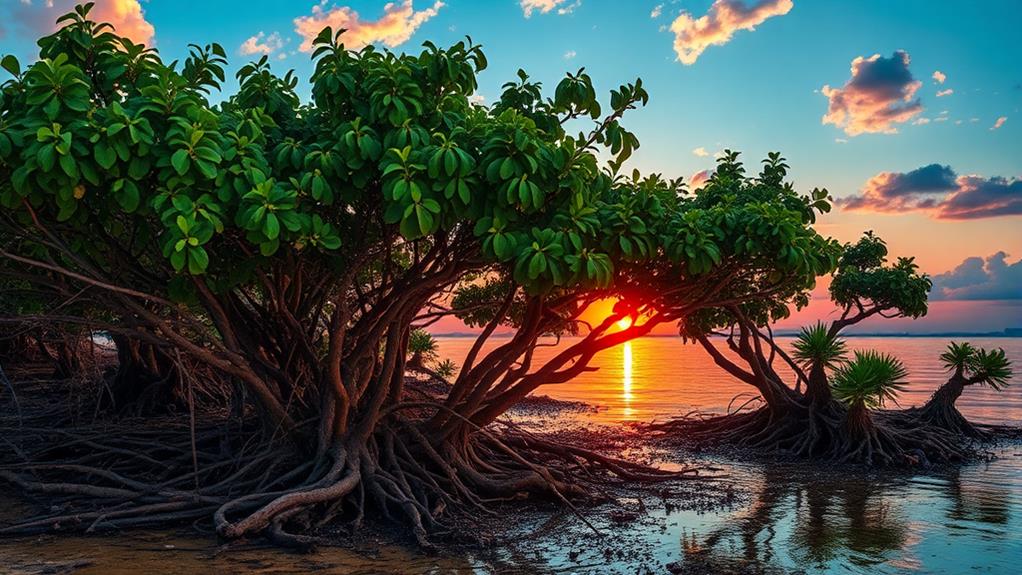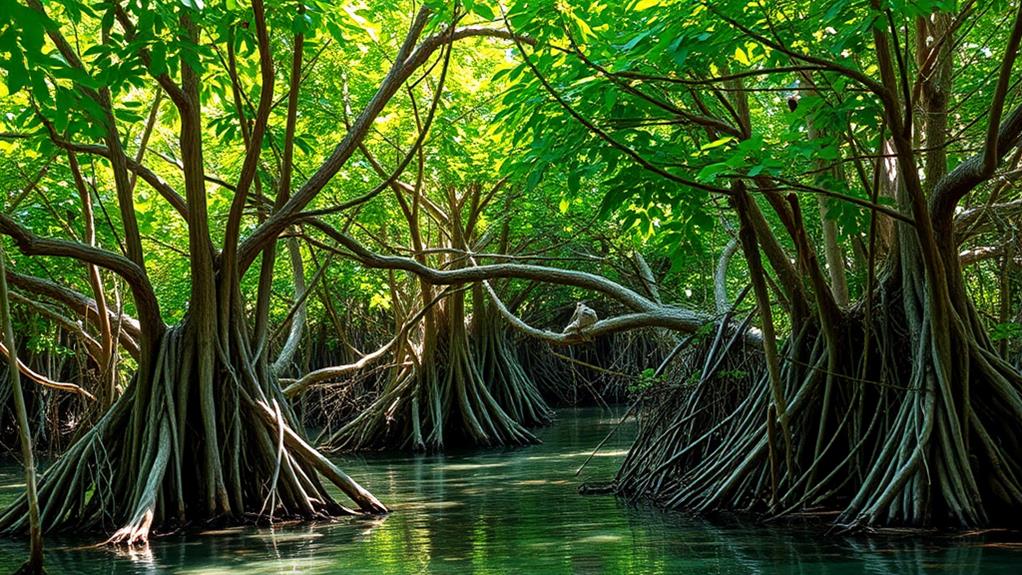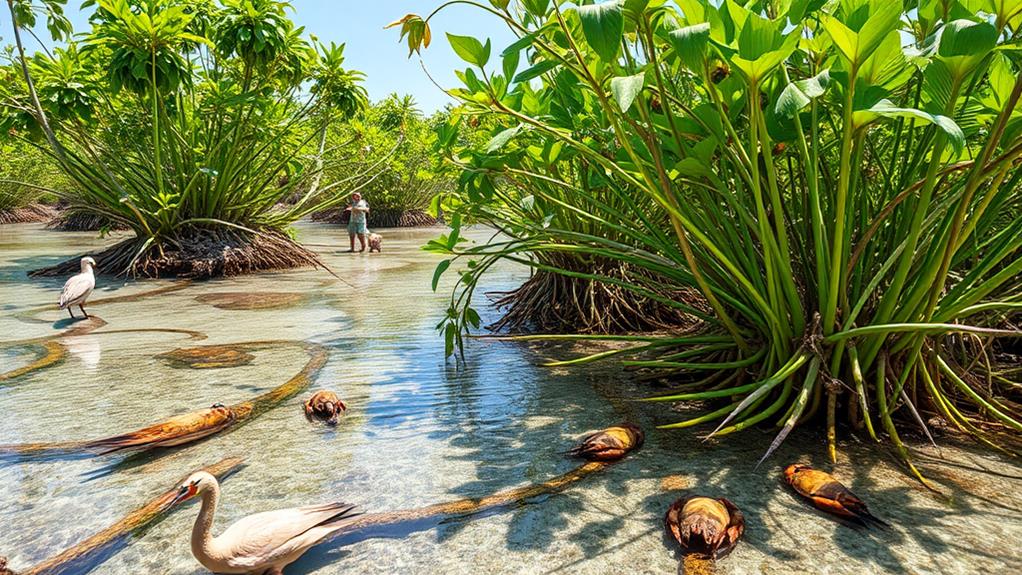Mangrove trees have adapted to thrive in coastal environments. They develop specialized roots to anchor themselves in shifting soil and water, and their thick leaves conserve water in salty conditions. These unique features allow them to flourish in tropical regions, supporting diverse ecosystems.
Mangroves serve as crucial nurseries for over 1,500 marine species, providing a safe habitat for them to grow and develop. They also protect coastlines from erosion and storm surges by stabilizing the soil with their roots and absorbing wave energy.
However, mangroves face significant threats, including deforestation and pollution, which impact their essential ecological roles.
Conservation efforts are vital to safeguard these habitats and the biodiversity they support. By preserving mangrove ecosystems, we can protect the rich array of species that depend on them and maintain the health of our coastlines.
Importance of Mangroves

Mangroves are crucial components of coastal ecosystems, playing a vital role in mitigating climate change and supporting biodiversity.
They serve as effective carbon sinks, capturing CO2 at rates up to five times greater than terrestrial forests, storing an average of 1,000 tonnes of carbon per hectare. This helps to reduce the impact of climate change by sequestering carbon dioxide.
Mangroves also provide essential coastal protection, reducing wave heights by 5-35% during storms and tsunamis, which safeguards coastal communities from devastating weather impacts.
These ecosystems support a significant level of biodiversity, providing critical habitats for a variety of migratory and endemic bird species. However, habitat degradation driven by human activities has led to substantial biodiversity loss, threatening the intricate web of life that relies on mangroves.
Restoration projects focused on mangrove rehabilitation are essential to revive these ecosystems, ensuring that they continue to support marine environments and the livelihoods of coastal communities.
In fact, the economic benefits of mangroves are estimated at $1,648 billion globally.
Geographic Distribution
Mangrove Ecosystems: Geographic Distribution
Mangrove ecosystems are primarily found in tropical and subtropical regions, thriving along sheltered coastlines between latitudes 25°N and 25°S. They cover approximately 53,000-77,000 square miles (138,000-200,000 square km) globally.
Regional Distribution
Mangroves extend from the Southern United States to countries like Mexico, Panama, Peru, Brazil, and throughout the Caribbean. There are roughly 54 true mangrove species, classified into 16 families based on physical and ecological traits rather than lineage. The number of mangrove species varies by region:
| Region | Mangrove Species Count |
|---|---|
| Southern U.S. | Varies by location |
| Mexico | 10-15 |
| Panama | 5-10 |
| Brazil | 20+ |
| Caribbean | 15-20 |
Influencing Factors and Importance
Climate and local conditions influence the geographic distribution of mangroves. Some species expand their range beyond typical limits, such as in Eastern Australia, where non-native species may also flourish. Mangroves are vital to coastal ecosystems, acting as a transition zone between land and sea, supporting both marine and terrestrial biodiversity. They contribute to carbon storage, enhancing climate resilience.
Conservation Efforts
Understanding mangrove distribution is essential for conservation efforts aimed at protecting these critical ecosystems.
Unique Adaptations

Mangrove trees have evolved unique adaptations to survive and thrive in harsh coastal environments.
Their specialized roots, such as stilt roots and pneumatophores, provide stability in oxygen-poor, saline habitats and facilitate vital gas exchange. These roots enable mangroves to survive in salinities up to 75 parts per thousand (ppt).
Mangroves have developed dense root mats that anchor them in sandy and muddy soils, significantly reducing coastal erosion and offering protection against storm surges. For example, species like Rhizophora mangle develop aerial roots, allowing them to access atmospheric oxygen during flooding events in intertidal zones.
Mangroves have adapted to conserve moisture in their challenging habitats. Thick, leathery leaves with a waxy cuticle help minimize water loss, enabling mangroves to thrive in extreme conditions.
These unique adaptations not only enable mangroves to survive but also support rich biodiversity, creating essential ecosystems that benefit various marine and terrestrial species.
Ecological Roles
Mangrove trees play a vital role in maintaining the health of coastal ecosystems through several mechanisms.
Nursery Habitat: Mangrove ecosystems serve as crucial nurseries for various marine life, including fish, crabs, and mollusks.
Over 1,500 species of marine life rely on these habitats for early development, which enhances biodiversity.
Erosion Control: The dense root systems of mangrove trees stabilize coastlines and reduce erosion, protecting against storm surges and mitigating damage during extreme weather events.
Water Quality: Mangroves filter pollutants and trap sediments, improving water quality and benefiting both marine and terrestrial ecosystems.
This process improves overall ecosystem health.
Carbon Sequestration: Mangroves act as significant carbon sinks, capturing and storing large amounts of carbon.
This contributes to climate change mitigation and promotes ecological health in coastal regions.
Biodiversity Support: Mangroves provide habitat for migratory and endemic birds, strengthening ecological networks.
Biodiversity Support

Mangrove ecosystems are crucial for maintaining biodiversity as they provide habitats and resources for a vast array of species. Over 1,500 species are supported by these ecosystems, with around 15% of them classified as threatened. The complex root systems of mangroves create rich habitats that enhance resilience within coastal ecosystems, allowing both marine and terrestrial life to thrive.
Mangroves serve as vital nursery habitats for commercially important species like fish, crabs, and shrimp. This contributes significantly to local fisheries and supports food security for coastal communities. In fact, the loss of just one square mile of mangroves can lead to a staggering loss of 275,000 pounds (124 metric tons) of fish annually. This highlights their essential role in sustaining marine populations.
Mangroves also provide critical habitat and shelter for migratory and endemic birds, enhancing biodiversity and supporting complex food webs.
Threats and Challenges
Mangrove ecosystems are under severe threat, primarily due to human activities such as deforestation for aquaculture, agriculture, and logging. Over the past 50 years, more than a third of global mangrove area has been lost, leading to devastating consequences.
Pollution poses a significant threat to mangrove health. Pesticides, sewage, and oil spills contaminate the water and soil, harming the delicate ecosystem. For instance, oil spills can suffocate mangrove roots, causing widespread death.
Rising sea levels threaten coastal habitats, making them more vulnerable to climate change. As sea levels rise, mangroves are unable to migrate inland, leading to erosion and loss of habitat.
Biodiversity loss is staggering, with nearly 15% of species dependent on mangroves classified as threatened. Many species, such as the proboscis monkey and the mangrove finch, rely on mangroves for food, shelter, and breeding grounds.
A lack of awareness hinders effective conservation and restoration efforts. Many people are unaware of the importance of mangroves, leading to inadequate protection and conservation measures.
Immediate action is necessary to combat these challenges. Scientists emphasize the need for comprehensive approaches, including scientific research and community engagement, to raise awareness about the importance of mangroves.
Conservation Efforts

Conservation Efforts are Crucial for Mangrove Ecosystems
As biodiversity loss escalates, effective conservation efforts are critical for the survival of mangrove ecosystems. Establishing carbon stock baselines is essential, as demonstrated by the Panama Audubon Society's Blue Natural Heritage project. This project revealed that monitored sites hold 87 tons of aboveground carbon per hectare, highlighting the importance of mangroves in climate regulation and biodiversity support.
Conservation Strategies Identify Key Species for Protection
Conservation strategies, such as the Parita Bay Conservation Plan, identify key mangrove species for protection, ensuring local efforts align with broader biodiversity commitments.
Innovative mapping processes utilizing AI and remote sensing are enhancing mangrove management, making it easier to monitor changes and implement restoration initiatives.
International Collaboration and Community Engagement are Vital
The Global Mangrove Alliance fosters international collaboration, addressing the urgent need for conservation amidst ongoing biodiversity decline.
Engaging local communities through education programs is essential, as it raises awareness of the ecological importance of mangroves and fosters support for conservation initiatives.
Economic and Community Benefits
Mangroves significantly contribute to local economies and community well-being through ecosystem services. These coastal ecosystems are essential for food security and livelihoods, providing critical protein sources for approximately 1.5 billion people globally.
Mangroves support sustainable tourism, attracting visitors and boosting local economies. For example, in some regions, mangrove-based tourism generates millions of dollars in revenue each year.
Healthy mangroves support valuable fisheries, with an estimated annual value of around $100 million in places like Mantang. Moreover, mangrove restoration efforts can add up to 60 trillion young fish and invertebrates, enhancing food security.
The economic significance of mangroves is substantial, with an estimated worth of $1,648 billion. This value highlights the importance of preserving and restoring these vital ecosystems.
Questions and Answers
How Do Mangroves Adapt to the Coastal Environment?
Mangroves' Specialized Roots Combat Coastal Erosion
Mangroves have adapted to coastal environments by developing specialized root systems. These roots stabilize sediments, preventing coastal erosion. For example, mangrove species like Rhizophora and Avicennia have above-ground prop roots that anchor themselves in the sediment, while others like Sonneratia have below-ground cable roots that spread out to stabilize the soil.
Mangroves Create Vital Habitats and Enhance Ecosystem Health
By thriving in tidal zones, mangroves create vital habitats that support diverse wildlife. These habitats are home to a wide range of species, including fish, crustaceans, and birds.
Additionally, mangroves enhance nutrient cycling by trapping sediments and nutrients that would otherwise be lost to the ocean.
Mangroves Provide Natural Water Filtration and Climate Resilience
Mangroves' extensive root networks also provide natural water filtration, improving ecosystem health. The roots act as a filter, trapping pollutants and sediments, and allowing clean water to flow through.
Furthermore, mangroves boost climate resilience by offering crucial ecosystem services like storm surge protection and acting as a refuge for various species, ensuring the balance of coastal ecosystems.
How Do Mangroves Contribute to Biodiversity?
Mangrove ecosystems significantly contribute to biodiversity by creating vital habitats and nursery grounds for numerous species. These ecosystems provide shelter and food for over 1,300 species of fish and 300 species of birds, while also enhancing plant diversity.
For example, the propeller-shaped roots of mangrove trees offer a safe haven for juvenile fish and crustaceans, allowing them to grow and develop.
Mangroves act as wildlife corridors, facilitating species interactions and movement. This enables species to migrate between habitats, find mates, and adapt to changing environmental conditions.
For instance, mangroves connect coral reefs and seagrass beds, allowing fish to move between these ecosystems.
Mangroves play a crucial role in carbon storage, with a single hectare capable of storing up to 1,000 tons of carbon. This helps maintain ecological balance and ensures the health of coastal environments.
Additionally, mangroves provide coastal protection by reducing wave energy and preventing erosion, protecting human settlements and infrastructure from the impacts of storms and sea-level rise.
What Adaptations Do Mangrove Trees Have to Deal With Living in Saltwater?
Mangrove trees have evolved unique adaptations to survive in saltwater environments.
Their root structures are specialized to stabilize sediment and facilitate oxygen diffusion. For instance, mangroves have developed above-ground roots called pneumatophores, which allow them to breathe oxygen from the air. This adaptation is crucial in low-oxygen saltwater environments.
Mangroves have developed mechanisms to manage excess salinity. They can filter out salt from seawater through their roots, and excrete excess salt through specialized glands on their leaves. This enables them to maintain a stable internal environment despite the salty surroundings.
Thick leaves help mangroves retain water, minimizing moisture loss in the salty atmosphere. This adaptation is essential for their survival in environments where freshwater is scarce.
Mangroves' reproductive strategies contribute to habitat creation and nutrient cycling. They produce propagules, which are essentially baby trees, that fall into the water and establish new habitats.
This process enhances ecosystem resilience and provides storm protection, ensuring the mangroves' continued growth in challenging coastal conditions.
Why Mangrove Trees Are Important to Their Coastal Habitats?
Mangrove trees are vital components of coastal ecosystems due to their multifaceted roles.
They provide coastal protection by stabilizing soil and preventing erosion, which mitigates the impact of floods. For example, during hurricanes, mangrove roots act as a natural barrier, shielding coastal communities from damage.
Mangroves serve as nursery habitats for various marine species, including fish and crabs. These habitats provide a safe haven for young animals to grow and develop, contributing to the overall health of the ecosystem.
The unique ecosystem of mangroves functions as a wildlife refuge, supporting a diverse range of species and enhancing biodiversity. This is evident in the variety of birds, reptiles, and mammals that inhabit mangrove forests.
Mangroves are efficient carbon sinks, exceling in carbon sequestration. By absorbing and storing carbon dioxide, they play a crucial role in combating climate change.
Mangroves also provide economic benefits through sustainable industries like fisheries and tourism. These activities not only generate income but also promote the conservation of mangrove ecosystems, fostering climate resilience and healthy coastal environments.